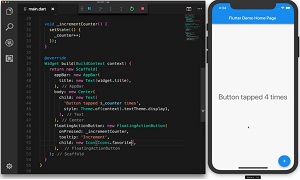News
Google Ships Flutter SDK Release Preview for Native iOS, Android Apps
- By David Ramel
- June 20, 2018
Google has shipped the first release preview of its open source Flutter SDK, which uses the company's Dart programming language to build native iOS and Android mobile apps.
In addition to its heavy leveraging of Dart (it also has a thin layer of C/C++ code), Flutter is unique in that it uses its own rendering engine to create widgets, instead of using native widgets. This lends the SDK to creating "brand" apps that don't mimic the look-and-feel of native apps, but rather convey brand identities through the use of app designs featuring custom fonts, colors, shapes, motion and so on. Flutter doesn't rely upon WebViews for presentation and is optimized for 2D native apps.
Although Google took the wraps off Flutter way back in 2015 and subsequently progressed it through a series of betas (beta 3 shipped last month will full Dart 2 support) and is just now hitting its first release preview, it's already used in several high-profile mobile apps, including the Alibaba shopping app, Google's own AdWords app, and the app for Hamilton musical production.
Since trumpeting the production use of Flutter at the company's Google I/O conference last month, Google's engineers and community volunteers have improved the product on many fronts in anticipation of today's Preview Release 1.
 [Click on image for larger, animated GIF.]
Flutter in Animated Action, Showing Hot Reload (source: Google)
[Click on image for larger, animated GIF.]
Flutter in Animated Action, Showing Hot Reload (source: Google)
"We are encouraged by the growing number of contributions we’re seeing from the broader community," Flutter Editor Tim Sneath said in a post today. "External contributions to Release Preview 1 include Flutter support for hardware keyboard and barcode scanners, video recording, and including a folder of image or font assets. In addition, we’re seeing many new packages contributed to the package site, such as Flutter Platform Widgets, a set of widgets that automatically adapt for iOS or Android; mlkit, a wrapper for the Firebase MLKit APIs; and Sequence Animation, which helps with constructing a series of connected animations."
Sneath said Google's own Flutter dev team is also working on widgets, specifically experimental instructions on adding Flutter widgets to an existing Android or iOS app. "While some iOS and Android apps in production already use this approach, we are working on improving our documentation and tooling to make it much easier to develop a mixed app," he said. "Keep an eye on this wiki article to follow our progress."
Other dev tooling improvements have been made to the Flutter extension for the Visual Studio Code editor, available in the Visual Studio Code Marketplace. It has nearly 58,000 installations as of the time of this writing and has earned a perfect 5.0 rating from three reviewers.
Sneath said updates to the VS Code extension include a new outline view, statement completion and the ability to launch emulators from within the editor.
In addition to the VS Code editor, Sneath pointed to the community-generated Flutter Studio, a Web-based tool for creating Flutter-based user interfaces.
Sneath invited developers to put the release preview through its paces as the project moves to full production readiness, citing trainings resources available such as:
About the Author
David Ramel is an editor and writer at Converge 360.